Abstract
Leaf angle is a key parameter that determines plant architecture and crop yield. Hormonal crosstalk involving brassinosteroid (BR) plays an essential role in leaf angle regulation in cereals. In this study, we investigated whether abscisic acid (ABA), an important stress-responsive hormone, co-regulates lamina joint inclination together with BR, and, if so, what the underlying mechanism is. Therefore, lamina joint inclination assay and RNA sequencing (RNA-Seq) analysis were performed here. ABA antagonizes the promotive effect of BR on leaf angle. Hundreds of genes responsive to both hormones that are involved in leaf-angle determination were identified by RNA-Seq and the expression of a gene subset was confirmed using quantitative real-time PCR (qRT-PCR). Results from analysis of rice mutants or transgenic lines affected in BR biosynthesis and signaling indicated that ABA antagonizes the effect of BR on lamina joint inclination by targeting the BR biosynthesis gene D11 and BR signaling genes GSK2 and DLT, thus forming a multi-level regulatory module that controls leaf angle in rice. Taken together, our findings demonstrate that BR and ABA antagonistically regulate lamina joint inclination in rice, thus contributing to the elucidation of the complex hormonal interaction network that optimizes leaf angle in rice.
1. Introduction
Leaf angle, defined as the inclination between the leaf blade midrib and the vertical stem of a plant, is an essential component of plant architecture and crop yield [1,2,3,4]. Under good management and appropriate environmental conditions, plants with erect leaves (small leaf angle) show enhanced grain yield per unit area in dense planting populations, due to increased leaf area index (LAI) and photosynthetic efficiency [5,6]. For example, the grain yields of the brassinosteroid (BR)-deficient rice mutant Osdwarf4-1, which has erect leaves, is greater in densely planted populations [7]. Therefore, an increasing number of recent studies have focused on identifying the responsible genes/quantitative trait loci (QTLs) that control leaf angles in major crop plants, including rice [8,9,10], maize [11,12,13], and wheat [14,15]. Most recently, two novel QTLs, upright plant architecture1 (UPA1) and UPA2, have been identified to regulate leaf angle in maize, thus providing the potential to enhance maize yields by increasing planting densities [16].
Leaf angle depends on cell division, expansion, and cell wall composition in the lamina joint [17]. Multiple external and internal factors, including nutrients, carbon dioxide, temperature, phytohormones, and plant genotypes, are involved in modulating leaf angle [10,17,18]. Among these regulators, phytohormone BR is the most important leaf-angle determinant. At present, almost the complete BR signal transduction pathway has been established for the model plant Arabidopsis [19], and several key BR signaling elements have also been well-characterized in rice, includingbrassinosteroid-insensitive1 (OsBRI1), glycogen synthase kinase 2/shaggy-like kinase (OsGSK2) and dwarf and low-tillering (DLT) [20]. OsBRI is localized in the plasma membrane and perceives BR and activates the BR signaling pathway [21]. OsGSK2, the rice ortholog of BR-insensitive 2 (BIN2) in Arabidopsis, functions as the central negative regulator of BR signaling by directly phosphorylating and inactivating downstream transcription factors, including DLT [22]. DLT is a GRAS family protein and is a positive regulator of BR signaling and mediates multiple BR responses in rice [22,23,24].
Leaf angle is the most distinctive BR-responsive architectural trait in cereals and ample evidence indicates that BR-deficient or -insensitive mutants exhibit reduced leaf angles in rice and maize [7,16,21,22,25,26]. Conversely, the exogenous application of BR or the genetic enhancement of BR signaling strikingly increased leaf angle [16,22,25]. Therefore, BR might represent a potential biotechnological target with which to enhance crop yield by modulating leaf angle [27]. However, considering the pleiotropic effects of BR on plants, other traits such as seed size and plant height are often closely associated with plant leaf-angle phenotypes [24,28,29]. Thus, attention has focused on identifying novel regulators that interact with the BR pathway and coordinate multiple key cereal agronomic traits, including leaf angle. Among these points of regulation, BR-centered hormonal crosstalk is essential for regulating leaf angle. In rice, both BR and GA promote an increase in leaf angle and the degree of their interaction depends on the respective hormone concentrations [30]. Recently, OsmiR396d was implicated in BR–GA co-regulation of leaf angle in rice [31]. The effect of BR and auxin interaction in regulating leaf angle is more complex. Generally, the co-application of BR and auxin has a greater effect in promoting leaf angle than either single hormone treatment [1]. However, rice mutants lacking free auxin have an enhanced BR content and as a consequence, more horizontal leaves [8,32], suggesting that auxin homeostasis is involved in leaf angle regulation. Recently, TaSPL8, which encodes a Squamosa-promoter binding protein-like (SPL) protein, was demonstrated to control wheat lamina joint development and leaf angle by modulating auxin signaling and BR biosynthesis [15].
Another well-studied phytohormone with an essential role in plant development and adaptation to stress is ABA [33]. In general, BR and ABA have antagonistic regulatory effects. However, the underlying molecular mechanisms have only been recently elucidated by the characterization of BR and ABA signaling pathways. Recently, mechanisms of interaction between BR and ABA have been identified in seed germination [34,35,36], root elongation [37,38,39], stomatal movement [40,41], hypocotyl elongation [42], and drought stress [43]. These represent several nodes of crosstalk and a complex molecular interaction network has been established. However, whether BR and ABA also interact to regulate cereal leaf angles and the underlying molecular mechanism, remains unclear.
In the present study, lamina joint inclination analysis was applied to evaluate the potential interaction between BR and ABA in controlling leaf angle of rice. A number of rice mutants or transgenic lines affected in BR biosynthesis and signaling were used for further identifying the integration nodes. Furthermore, RNA-seq analysis was accomplished by using the leaf segments to identify genes responsive to both BR and ABA that are involved in leaf-angle determination. Our findings will contribute to the understanding of the complex hormonal interaction network that optimizes leaf angle.
2. Results
2.1. ABA Antagonizes the Promotion of Lamina Joint Inclination by BR in Rice
The comparison results of lamina joint inclination test showed that the samples exhibited the same leaf-angle responses in both tube-based and Petri-dish-based BL treatment systems, i.e., leaf angle increased together with an increase in BL concentration. However, the leaf-angle response of samples on Petri-dishes was greater than that of samples in tubes (Figure S1A,B). For example, following treatment with 10−7 M BL, the mean leaf angle of samples in tubes was 57.2°, whereas that of samples on Petri-dishes was 100.1°. Moreover, the increase in leaf angle was slight at BL concentrations greater than 10−7 M in the Petri-dish-based system. Therefore, 10−7 M BL treatment on Petri-dishes was chosen for subsequent experiments. To analyze the effect of ABA on leaf angle and to establish a suitable ABA treatment concentration, rice leaf segments were treated with different concentrations of ABA in the presence or absence of 10−7 M BL. Leaf angle decreased following treatment with ABA in a concentration-dependent manner. Moreover, when leaf segments were treated with BL and ABA simultaneously, ABA suppressed the positive effect of BL on lamina joint inclination. For example, BL alone resulted in a 91° leaf angle, whereas co-application of 50 mM ABA and 10−7 M BL resulted in a 26.9° leaf angle, which was similar to that of samples treated with ABA alone (Figure 1).
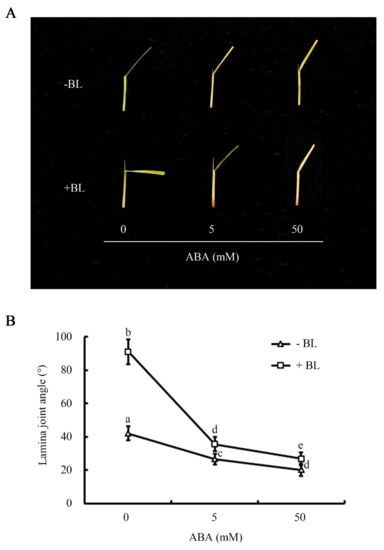
Figure 1.
Abscisic acid(ABA) antagonizes the effect of brassinosteroid(BR) on lamina joint inclination in Nipponbare (Nip, Oryza sativa L.). (A) Responses of leaf segments from etiolated seedlings to different concentrations of ABA in the presence or absence of brassinolide (BL) (10−7 M). (B) Quantitative data for lamina joint angle analysis. Data were analyzed by analysis of variance (ANOVA) by Pearson’s correction. Error bars represent SD (n = 20 seedlings). Bars with different letters indicate statistically significant differences at p < 0.05.
2.2. Modulating the Expression of BR Biosynthesis Genes Plays an Important Role in ABA Regulation of Lamina Joint Inclination
To explore why ABA treatment almost abolished the promotive effect of BR on lamina joint inclination, the expression of several key genes involved in BR biosynthesis, BR signaling, and cell elongation was analyzed. The expression of the three BR biosynthesis genes ebisu dwarf (D2), dwarf 11(D11) and OsDWARF 4 (OsDWF4) was slightly suppressed by BL treatment. However, ABA treatment promoted the expression of D2 and OsDWF4 but inhibited that of D11, independent of the presence of BL (Figure 2). The decrease in expression of OsBRI1, which encodes the BR receptor, in response to BL, was partially counteracted by ABA treatment. The genes encoding brassinazole-resistant 1 (OsBZR1) and DLT, two key transcription factors involved in rice BR signaling were differentially affected in response to hormone treatment. Transcription of OsBZR1 was more or less unaffected by BL or ABA treatment, whereas that of DLT decreased markedly. The expression of genes related to cell elongation all increased in response to BL or ABA treatment, although co-application of both hormones slightly reduced the expression of brassinosteroid upregulated1(BU1) but enhanced the expression of xyloglucan endotransglycosylase/hydrolase 1 (OsXTH1) and phosphate-induced protein-1 (OsPHI-1). Although no consistent changes in expression were observed among the gene classes analyzed, we hypothesized that modulation of D11 expression is important for the BR–ABA-mediated regulation of leaf angle. The reasons for this are that D11 was most highly expressed in leaf segments (Figure S2) and the change in D11 expression in response to BL and ABA was consistent with the results of the lamina joint inclination assay, i.e., ABA suppressed leaf angle and D11 expression, even in the presence of BL.
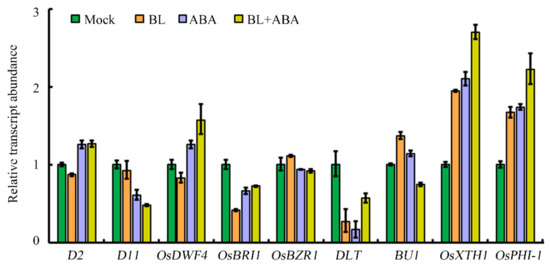
Figure 2.
Expression analysis of BR-related genes in Nipponbare treated with BL and/or ABA. Ubiquitin-conjugating enzyme(UBC) was used as an internal control. Mock refers to dimethylsulfoxide (DMSO) solution. Values were obtained from three independent experiments.
2.3. Interaction between ABA and BR Biosynthesis Pathways in Lamina Joint Inclination
The most distinctive feature of m107 mutant is its large leaf angle during the mature stage, making it an ideal genetic background to assess the contribution of D11 and BR biosynthesis in regulating leaf angle together with ABA. In the absence of hormone treatment, the leaf angle of the m107 mutant was 88.2°, which was greater than that of the Nip control (49.1°) in the Petri-dish-based experimental system. Furthermore, the leaf angle of mock-treated m107 was similar to that of BL-treated Nip, suggesting that the overexpression of D11 due to the dominant mutation indeed enhanced endogenous BR biosynthesis, resulting in a similar effect to exogenous BL treatment. Although ABA treatment still caused a sharp reduction in the m107 leaf angle, it remained significantly larger than that of wild-type (WT) in the same treatment conditions (Figure 3A,B), indicating that modulating BR biosynthesis contributes to the ABA-mediated regulation of lamina joint inclination.
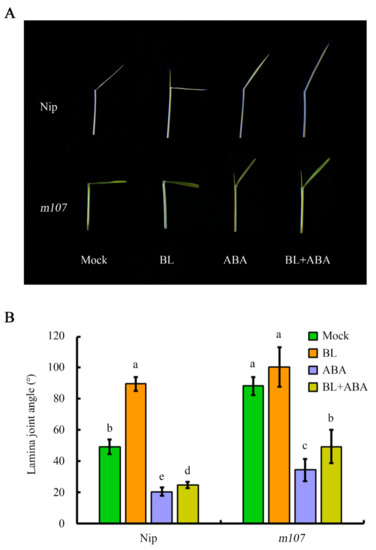
Figure 3.
Antagonistic effect of ABA on BR biosynthesis in the regulation of lamina joint inclination. (A) Effect of ABA and BR on leaf angle in m107 mutant and wild type Nip (Oryza sativa L.). (B) Quantitative data for lamina joint angle analysis in (A). Data were analyzed by analysis of variance (ANOVA) with Pearson’s correction. Error bars represent SD (n = 20 seedlings). Bars with different letters indicate statistically significant differences at p < 0.05.
2.4. Identification of the Genes Commonly Responsive to BR and ABA via RNA-Seq
Phytohormones often converge on a set of common target genes to coordinate plant growth and development [44]. Therefore, the identification of genes co-regulated by BR and ABA contributes to understanding the molecular mechanisms that underlie leaf-angle regulation. We used RNA-Seq to identify differentially expressed genes (DEGs) in response to ABA and/or BL treatment. Treatment with ABA or BL alone or co-treatment with both hormones caused the change in expression of thousands of genes, among which, there were 464 common DEGs to all three experimental sets (Figure 4, Table S2). First, the 464 genes were classified into different cluster groups by hierarchical clustering analysis (Figure 5A), suggesting that they perform different roles in mediating ABA–BR crosstalk in controlling leaf angles. Next, these genes were assigned to nine different groups according to their biological processes (Figure 5B). Among these groups, genes belonging to ‘metabolic process’ and ‘cellular process’ constituted the two largest groups and accounted for 36.5% and 28.8% of total analyzed genes, respectively. Based on the annotations of their encoded proteins, the genes could be classified into 17 subfamilies, among which ‘oxidoreductase’ accounted for the largest proportion (17.6%), followed by ‘transferase’ and ‘hydrolase’, which accounted for 16% and 15.3% of the total analyzed genes, respectively (Figure 5C).
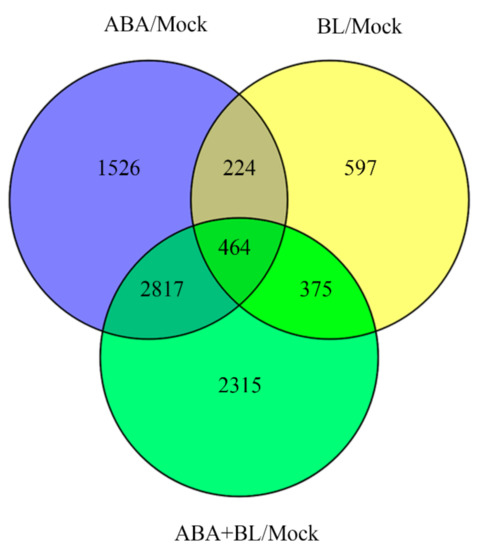
Figure 4.
Venn diagram illustrating the number of common target genes in response to ABA, BL, and their combination.
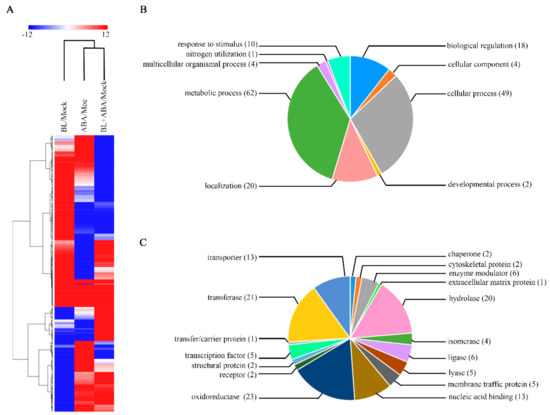
Figure 5.
Hierarchical cluster analysis and functional analysis of common differentially expressed genes (DEGs) in three different treatment conditions. (A) Hierarchical cluster analysis of common genes in response to BL and/or ABA. Common responsive genes are presented in biological process (B) and protein class (C) using gene ontology (GO) analysis.
Next, eight genes out of the 464 common DEGs were randomly selected for qRT-PCR validation. The quantitative expression data confirmed that most selected genes exhibited a similar change in expression to that observed in the RNA-Seq dataset (Figure 6 and Figure S3). For example, the expression of Os01g0678000 and Os11g0635500 were induced by BL, but were suppressed by ABA with or without BL, suggesting that the RNA-Seq data are reliable and that many genes are involved in the ABA–BR co-regulation of leaf angle in rice.
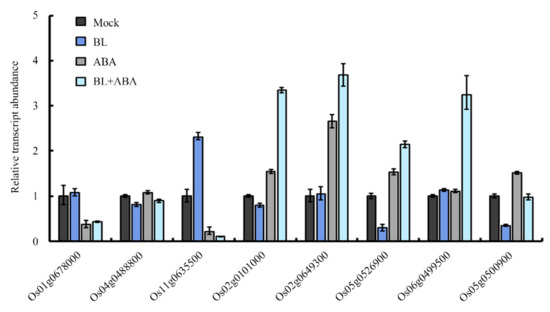
Figure 6.
Validation of RNA-Seq data by quantitative real-time polymerase chain reaction (qRT-PCR). Ubiquitin-conjugating enzyme(UBC) was used as an internal control and values were obtained from three independent experiments.
2.5. Suppression of Lamina Joint Inclination by ABA Does Not Depend on BR Perception
Hormone interactions can exist at the level of biosynthesis or signaling. The data here from exogenous BL treatment and using the m107 mutant suggested that BR biosynthesis is involved in BR–ABA crosstalk. Lamina joint angles were measured for mutant or transgenic rice lines for genes in the BR signaling pathway, to identify the BR signaling component(s) that mediate ABA–BR crosstalk. We first examined whether a functional BR receptor is required for the reduction in lamina joint inclination caused by ABA. Thus, leaf segments of d61-1, a weak allele of BRI1, which encodes the BR receptor, were tested for their response to hormone treatment. The leaf angle of d61-1 was smaller than that of the wild-type under either mock or BL treatments. However, ABA treatment alone or together with BL resulted in a similar leaf angle in d61-1 and WT (Figure 7A,B), suggesting that the inhibitory effect of ABA on leaf angle resided downstream of the BR receptor.
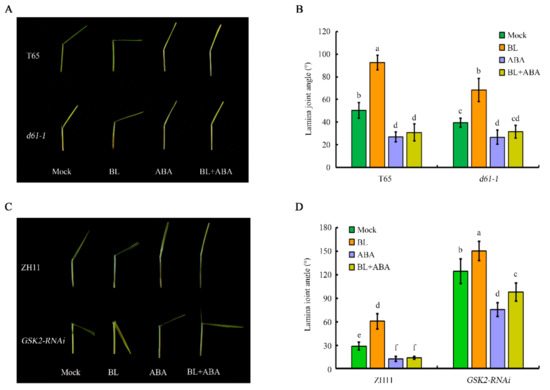
Figure 7.
Antagonistic effect of ABA on BR signaling in regulating lamina joint inclination. (A) and (B) Effect of ABA and BR on leaf angle in the d61-1 mutant and wild type Taichung 65 (T65, Oryza sativa L.). (C) and (D) Effect of ABA and BR on leaf angle in transgenic rice GSK2-RNAi and wild type Zhonghua 11 (ZH11, Oryza sativa L.). Data were analyzed by analysis of variance (ANOVA) with Pearson’s correction. Error bars represent SD (n = 20 seedlings). Bars with different letters indicate statistically significant differences at p < 0.05.
2.6. BR and ABA Crosstalk in Establishing Lamina Joint Angle Is Partially Mediated by GSK2
Because GSK2 is the major negative regulator within the BR signaling pathway, we measured the lamina joint angle of GSK2-RNAi transgenic rice, which was 124.6° without BL treatment and was greater than that of the ZH11 control, which was only 28.7° for the same treatment. BL treatment further increased the leaf angle of GSK2-RNAi plants to 150.2° compared to that of the WT control, which was only 60.7°. Treatment with ABA alone or together with BL markedly decreased the leaf angle of WT to less than 15°, but only caused a slight reduction in the leaf angle of GSK2-RNAi rice, which was 75.6° following ABA treatment alone and 97.9° following simultaneous ABA and BL treatment (Figure 7C,D). We, therefore, hypothesized that GSK2 kinase partially mediates BR–ABA crosstalk in controlling rice leaf angle. ABI1 and ABI2 are two ABA signaling components, which directly interact with and dephosphorylate BIN2, thus modulating its activity in phosphorylating BES1 in Arabidopsis. To verify whether the ABI1/ABI2–BIN2 interaction module also mediates ABA–BR crosstalk in controlling leaf angle in rice, yeast two-hybrid analysis was performed to examine whether GSK2 can physically interact with ABI-LIKE 1 (ABIL1)/ABIL2, the ABI1/ABI2 homologs in rice. The result indicated no interaction (Figure 8), suggesting that although GSK2 is one determinant of lamina joint angle in rice, it probably does not function via the ABI1/ABI2-BIN2 interaction module.
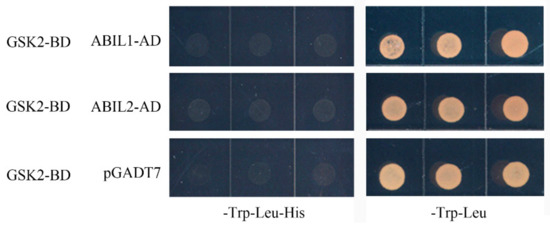
Figure 8.
No direct physical interaction was detected between glycogen synthase kinase 2 (GSK2) and ABI-like (ABIL) proteins. Yeast two-hybrid assay for the interaction between GSK2 and ABIL1 and ABIL2. Yeast cells transformed with bait (pGBKT7-GSK2) and prey (ABIL1 or ABIL2 cloned into pGADT7) were selected on SD-Trp/-Leu/-His medium. pGADT7 was the empty prey vector control.
2.7. DLT Represents a Major ABA–BR Crosstalk Node in Coordinating Lamina Joint Inclination
The analysis of GSK2-RNAi transgenic rice only partially explained the joint regulation of leaf angle by BR and ABA, implying that additional BR signaling component(s) are involved. Because previous reports indicated that DLT is a key regulator of rice lamina joint inclination [22], we tested the response of genetic backgrounds with altered DLT expression to BR and/or ABA treatment, to confirm whether DLT mediates BR–ABA crosstalk in rice leaf angle regulation. Loss of DLT function led to an almost completely erect-leaf phenotype and only BL treatment alone slightly increased the leaf angle. In the presence of BL, ABA application restored the leaf angle to the same as that of the mock-treated control (Figure 9A,B). Moreover, overexpression of DLT strikingly increased the leaf angle to 72.4°. Treatment with BL alone increased the leaf angle to 90.3° and ABA treatment decreased the leaf angle to 27.5° and 29.3°, in the presence or absence of BL, respectively. However, the leaf angle of ABA-treated DLT-OE rice was still greater than that of the ABA-treated ZH11 control. The response of DLT-OE rice in response to BL and/or ABA treatment was qualitatively similar to that of GSK2-RNAi rice. However, some differences were observed: Firstly, the leaf angle of GSK2-RNAi rice was always greater than that of DLT-OE rice in each treatment condition. Secondly, the reduction in the leaf angle of DLT-OE rice in response to ABA was greater than that of GSK2-RNAi plants. For example, the leaf angles of GSK2-RNAi rice were 124.6° and 75.6°, before and after ABA treatment, respectively, but were 72.4° and 27.5°, respectively, for the same treatments with DLT-OE rice (Figure 9A,B), representing a more than 60% reduction after ABA treatment. This suggests that DLT represents a crosstalk node that integrates BR and ABA signals to modulate rice leaf angle.
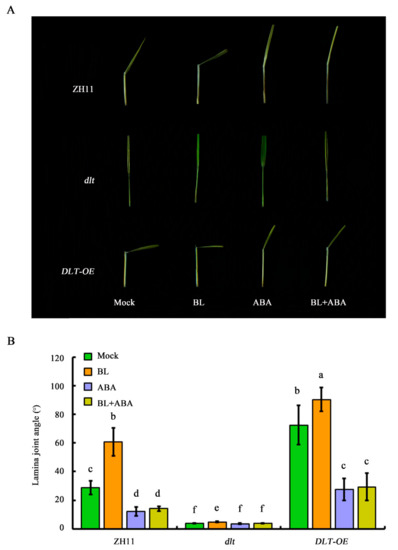
Figure 9.
Dwarf and low-tillering(DLT) is a major crosstalk node of ABA and BR pathways in coordinating lamina joint inclination. (A) and (B) Antagonistic effect of ABA and BR on lamina joint inclination in dlt, DLT-OE transgenic plants and wild type ZH11 (Oryza sativa L.). Data were analyzed by analysis of variance (ANOVA) by Pearson’s correction. Error bars represent SD (n = 20 seedlings). Bars with different letters indicate statistically significant differences at p < 0.05.
3. Discussion
The degree of lamina inclination is an important trait that determines crop architecture, photosynthetic efficiency and grain yield [7,17]. Various intrinsic hormonal signals and extrinsic environmental cues are involved in leaf angle regulation and these include BR as a major regulator, particularly in cereals [7,16]. Other phytohormones, including gibberellins, auxin, strigolactone, and JA are also involved in the regulation of leaf angle [1,30,45,46]. However, most of these hormones control leaf angle directly or indirectly by interacting with the BR pathway [1,30,45]. It remains uncertain whether ABA, an important stress-related hormone, also participates in leaf angle regulation and if so, what the underlying molecular mechanism is. In rice, the lamina joint inclination test is one of the most sensitive BR physiological assays and is closely related to leaf angle. Moreover, it is an ideal method with which to investigate the interactions between BR and other hormones in rice. Although evidence supports the existence of crosstalk between BR and ABA in co-regulating seed germination [34,35,36], hypocotyl elongation [42] and stress responses [43], no interaction in modulating rice leaf angle has yet been reported. In this study, evidences indicated that ABA alone can reduce the leaf angle of rice (Figure 1) and co-treatment with ABA and BL strikingly suppressed changes in lamina joint inclination induced by BR (Figure 1). These findings suggest that ABA indeed affects leaf angle in rice, most likely by suppressing BR functions.
BR and ABA are essential for a broad spectrum of plant growth and developmental programs. All hormones, including BR and ABA, control plant development by regulating the expression of a large number of downstream target genes. Therefore, the co-regulation of the same subset of downstream target genes represents one level of hormonal crosstalk [44,47]. Because BR is a major regulator of lamina joint inclination, the expression of several key genes related to BR biosynthesis, signaling, and cell elongation were analyzed by qRT-PCR. The D11 gene, which encodes the rate-limiting enzyme of BR biosynthesis, is a potential target of both BR and ABA in determining lamina joint inclination. Treatment with ABA alone or with BL reduced D11 expression. RNA-Seq was performed to identify additional downstream transcripts. A previous study in Arabidopsis revealed more than two hundred overlapping target genes of BL and ABA using a microarray approach [48]. However, a tissue-specific RNA-Seq-based transcriptome analysis, instead of using whole seedlings, can improve spatial resolution and provide more relevant data. In this study, 464 common DEGs were identified in rice leaf segments under three experimental conditions: BL or ABA treatment alone or their co-application. Subsequent qRT-PCR validation showed that for most genes, the change in expression was consistent with that of RNA-Seq data (Figure 6 and Figure S3), confirming the reliability of the transcriptome data. The identification of genes responsive to BL and ABA in the determination of leaf angle is essential for additional functional analyses. Further bioinformatic analysis indicated that more than 60% of these genes were involved in metabolic and cellular processes (Figure 5B). Moreover, nearly half of the genes were oxidoreductases, transferases, and hydrolases (Figure 5C). Several genes involved in phytohormone pathways were also identified. For example, OsGH3-4 and OsGH3-7, two auxin-responsive GH3 family genes, were regulated by BL and ABA. Another GH3 family gene, OsGH3-5, also integrates auxin and BR signaling to regulate rice leaf angle [8]. Therefore, the transcriptome data here implicate a role for additional genes in the complex regulatory network involving BL and ABA in coordinating rice lamina joint inclination.
In the absence of hormone treatment, the leaf angle of m107, the dominant mutant of D11, increased, similar to that of WT treated with exogenous BL. Following ABA treatment, the leaf angle decreased greatly, even in the presence of BL treatment (Figure 3A,B). However, the leaf angle of m107 was still significantly greater than that of WT under the same treatment conditions, suggesting that enhanced BR biosynthesis can partially attenuate the effect of ABA. Consistent with this, expression analysis indicated that ABA led to a decrease in D11 expression (Figure 2). Similar studies were also performed using several genetic backgrounds with modified BR perception or signaling, including the BR receptor mutant d61-1, an RNAi transgenic line of the negative regulator OsGSK2 and a mutant and overexpression line of the transcription factor DLT. These data indicated that integration of the BR and ABA pathways occurs downstream of the BRI receptor, since there was no difference in leaf angle between d61-1 and the WT in response to ABA (Figure 7). However, knocking down OsGSK2 expression led to a striking increase in the leaf angle in all hormone treatments. Although ABA treatment caused a decrease in the leaf angle to about 50%, the leaf angle of GSK2-RNAi plants was greater than that of the BL-treated WT control (Figure 7), indicating that GSK2 represents a major node of crosstalk between BR and ABA in leaf angle regulation. Recently, increasing evidence has demonstrated the crucial roles of BIN2/GSK2 in mediating interactions between BR signaling and other pathways in drought responses [43,49], hypocotyl elongation [42,50], seed size [51,52] and cellulose synthesis [53]. Therefore, BIN2/GSK2 might also integrate BR signaling with other pathways, in addition to BZR1/BES1 transcription factors [19]. Furthermore, the DLT transcription factor that functions downstream of GSK2 mediates several BR responses in rice [22,23,24,51]. Most importantly, DLT is involved in BR-induced rice lamina joint inclination: the leaf angle in the dlt mutant was relatively small and was hardly affected by BL treatment (Figure 9). However, DLT overexpression resulted in a larger leaf angle than WT, even in the presence of ABA. Thus, DLT function can attenuate the effect of ABA on lamina joint inclination.
In summary, we have shown that BR and ABA antagonistically regulate lamina joint inclination in rice. ABA antagonizes the positive effect of BR on a high lamina joint angle via the BR biosynthesis gene D11 and the BR signaling genes GSK2 and DLT, thus forming a multi-level regulatory module to control rice leaf angle. Our findings contribute to understanding the complex BR–ABA interaction network, which orchestrates functions of BR and ABA in diverse environmental conditions and thus coordinates plant growth and developmental programs.
4. Materials and Methods
4.1. Plant Materials
In this study, seedlings of rice (Oryza sativa L.) were used for the following experiments. In general, three different Japonica cultivars, including Nipponbare (Nip), Zhonghua 11 (ZH11), and Taichung 65 (T65), and derivative mutants or transgenic lines were used. In more detail, m107 is a D11 dominant mutant caused by the insertion of a double 35S enhancer T-DNA upstream from its start codon [54], and its wild-type counterpart is Nip. The GSK2-RNAi and DLT-OE transgenic lines and the dlt mutant all derived from recipient ZH11. d61-1 is a BR-insensitive mutant and its wild-type counterpart is T65. All rice plants were grown under the same climate and management conditions during the summer in a paddy field at Yangzhou University. Mature seeds from superior rice spikelets were collected for experiments.
4.2. Lamina Joint Inclination Assay
The lamina joint assay was performed according to [55] with some modifications. In brief, mature seeds were sterilized with 70% ethanol and rinsed twice with sterile water. Seeds were imbibed in darkness for two days and synchronously germinating seeds were selected and grown in the dark for a further eight days at 30 °C. Leaf segments, consisting of 1 cm of the second leaf blade, the lamina joint and 1 cm of the leaf sheath, were excised from the uniform seedlings. Leaf segments were then floated on Milli-Q water for 24 h and were dipped into a centrifuge tube or floated on a Petri-dish containing various hormone treatments in the dark for 48 h. Stock solutions of BL, ABA or an equal volume of ethanol were diluted in 2.5 mM maleic acid potassium solution for treatment. The lamina joint angle, formed by the lamina and leaf sheath, was measured using ImageJ software, a free and Java-based image-processing package supported by the National Institute of Health (https://imagej.nih.gov/ij/). Twenty seedlings were used for each treatment and all experiments were repeated at least three times.
4.3. Quantitative Real-Time PCR (qRT-PCR) Analysis
Leaf segments treated with either BL (10-7 M), ABA (50 mM), both hormones or an ethanol control for 12 h were used for RNA extraction and gene expression analysis. Total RNA was isolated using the RNeasy Plant Mini Kit (Qiagen, Hilden, Germany) and treated with DNase I (Qiagen). RNA quality and quantity were evaluated using a NanoDrop 2000 (Thermo Scientific, MA, USA) system. High-quality RNA samples were reverse-transcribed using the SuperScript First-Strand Synthesis System (Invitrogen, Van Allen Way Carlsbad, CA, USA) and qRT-PCR was performed using SYBR Premix Ex Taq (TaKaRa, Dalian, Liaoning, China) and an ABI PRISMTM 7700 sequence detector system (Applied Biosystems, Foster City, CA, USA). Relative expression was calculated using the 2−ΔΔCt method, and ubiquitin conjugase (UBC) was used as the internal control for normalization. Primers are listed in Supplementary Materials Table S1.
4.4. RNA-Seq Analysis
High-quality RNA was isolated and used for library construction, and high-throughput RNA sequencing was performed on a BGISEQ-500 platform at the Beijing Genomics Institute (BGI, Shenzhen, China). Raw sequencing reads were trimmed and the collected clean data were aligned to the genome of rice japonica cultivar Nipponbare (IRGSP-1.0, http://rapdb.dna.affrc.go.jp/) using TopHat2 software [56]. The DESeq2 (version 1.12.4) was used to determine differentially expressed genes (DEGs) [57], which were selected according to the following default criteria: A fold change ≥ 2.0 and FDR ≤ 0.001.
4.5. Bioinformatic Analysisand qRT-PCR Validation of RNA-Seq Data
The DEGs common to all three treatment experimental sets were isolated for the following validation and bioinformatic analysis. First, common DEGs were used to construct a heat map with Morpheus online software (https://software.broadinstitute.org/morpheus), a frequently used -omics method to study genes with similar expression patterns. Gene ontology (GO) was used for the classification of gene function and the description of genes or gene-product attributes. Using the PANTHER database, genes were analyzed with two sets of ontologies, including biological process and protein class [58]. Finally, qRT-PCR was used to validate the expression of eight randomly selected DEGs from the RNA-Seq data.
4.6. Yeast Two-Hybrid Assays
The full-length coding sequence of GSK2 was amplified and cloned into the pGBKT7 bait vector and transformed into the yeast strain AH109. Yeast cells carrying the bait vector were transformed with the prey plasmids containing the full-length coding sequences of ABIL1 or ABIL2. Transformants were selected on SD dropout plates. The assay was performed according to the manufacturer’s instructions (TaKaRa, Dalian, Liaoning, China).
4.7. Statistical Analysis
For sample characterization, at least three independent experiments were performed unless otherwise specified. All data represent the means ± standard deviation (SD) of the replicates. The data were analyzed by analysis of variance (ANOVA) with Pearson’s correction.
Supplementary Materials
Supplementary materials can be found at https://www.mdpi.com/1422-0067/20/19/4908/s1. Figure S1. Comparison between the Petri-dish-based and tube-based lamina joint inclination assay. Figure S2. Expression analysis of BR-related genes in Nipponbare. Figure S3. Transcript levels of selected target genes from RNA-Seq analysis. Table S1. Primers used for qRT-PCR analysis in this study. Table S2. The 464 common DEGs in response to ABA and/or BL treatment from RNA-seq analysis.
Author Contributions
Conceptualization and funding acquisition, Q.-F.L. and Q.-Q.L.; investigation, Q.-F.L., J.L., Y.Z., F.W.; methodology, Q.-F.L., J.L., Y.Z., F.W., H.-N.T., and J.-D.W.; resources, J.-W.Y. and C.-Q.Z.; validation, Q.-F.L. and X.-L.F.; writing—original draft, Q.F.L.; writing—review & editing, Q.-Q.L.
Funding
This research was supported by the National Natural Science Foundation of China (31825019, 31771745, 31601275), the Jiangsu Provincial Department of Education of China (17KJA210001), Jiangsu PAPD, Qinglan, Six talent peaks and Innovative and Entrepreneurial Talent projects.
Acknowledgments
We thank Chu Chengcai (Institute of Genetics and Developmental Biology, Chinese Academy of Sciences) for the seeds of dlt, DLT-OE and GSK2-RNAi, and Prof. Matsuoka Makoto (Nagoya University) for the seeds of d61-1 mutant.
Conflicts of Interest
The authors declare no conflict of interest.
Abbreviations
| ABA | abscisic acid |
| ABIL1 | ABI-like 1 |
| ANOVA | analysis of variance |
| BIN2 | BR-insensitive 2 |
| BL | brassinolide |
| BR | brassinosteroid |
| BU1 | brassinosteroid upregulated1 |
| BZR1 | brassinazole resistant1 |
| D2 | ebisud warf |
| D11 | dwarf 11 |
| DEGs | differentially expressed genes |
| DLT | dwarf and low-tillering |
| DMSO | dimethylsulfoxide |
| GO | gene ontology |
| GSK2 | glycogen synthase kinase 2 |
| LAI | leaf area index |
| OsBRI1 | brassinosteroid-insensitive1 |
| OsDWF4 | osdwarf 4 |
| OsXTH1 | xyloglucan endotransglycosylase/hydrolase 1 |
| PHI-1 | phosphate-induced protein-1 |
| qRT-PCR | quantitative real-time polymerase chain reaction |
| QTLs | quantitative trait loci |
| RNA-Seq | RNA sequencing |
| SD | standard deviation |
| SPL | Squamosa-promoter binding protein-like |
| UBC | ubiquitin-conjugating enzyme |
| UPA1 | upright plant architecture1 |
References
- Nakamura, A.; Fujioka, S.; Takatsuto, S.; Tsujimoto, M.; Kitano, H.; Yoshida, S.; Asami, T.; Nakano, T. Involvement of C-22-hydroxylated brassinosteroids in auxin-induced lamina joint bending in rice. Plant Cell Physiol. 2009, 50, 1627–1635. [Google Scholar] [CrossRef] [PubMed]
- Zhang, S.W.; Li, C.H.; Cao, J.; Zhang, Y.C.; Zhang, S.Q.; Xia, Y.F.; Sun, D.Y.; Sun, Y. Altered architecture and enhanced drought tolerance in rice via the down-regulation of indole-3-acetic acid by TLD1/OsGH3.13 activation. Plant Physiol. 2009, 151, 1889–1901. [Google Scholar] [CrossRef] [PubMed]
- Zhao, S.Q.; Hu, J.; Guo, L.B.; Qian, Q.; Xue, H.W. Rice leaf inclination2, a VIN3-like protein, regulates leaf angle through modulating cell division of the collar. Cell Res. 2010, 20, 935–947. [Google Scholar] [CrossRef] [PubMed]
- Ning, J.; Zhang, B.; Wang, N.; Zhou, Y.; Xiong, L. Increased leaf angle1, a Raf-like MAPKKK that interacts with a nuclear protein family, regulates mechanical tissue formation in the lamina joint of rice. Plant Cell 2011, 23, 4334–4347. [Google Scholar] [CrossRef] [PubMed]
- Sinclair, T.R.; Sheehy, J.E. Erect leaves and photosynthesis in rice. Science 1999, 283, 1455. [Google Scholar] [CrossRef]
- Lauer, S.; Hall, B.D.; Mulaosmanovic, E.; Anderson, S.R.; Nelson, B.; Smith, S. Morphological changes in parental lines of Pioneer brand maize hybrids in the U.S. central Corn Belt. Crop Sci. 2012, 52, 1033–1043. [Google Scholar]
- Sakamoto, T.; Morinaka, Y.; Ohnishi, T.; Sunohara, H.; Fujioka, S.; Ueguchi-Tanaka, M.; Mizutani, M.; Sakata, K.; Takatsuto, S.; Yoshida, S.; et al. Erect leaves caused by brassinosteroid deficiency increase biomass production and grain yield in rice. Nat. Biotechnol. 2006, 24, 105–109. [Google Scholar] [CrossRef]
- Zhang, S.; Wang, S.; Xu, Y.; Yu, C.; Shen, C.; Qian, Q.; Geisler, M.; de Jiang, A.; Qi, Y. The auxin response factor, OsARF19, controls rice leaf angles through positively regulating OsGH3-5 and OsBRI1. Plant Cell Environ. 2015, 38, 638–654. [Google Scholar] [CrossRef]
- Liu, J.M.; Park, S.J.; Huang, J.; Lee, E.J.; Xuan, Y.H.; Je, B.I.; Kumar, V.; Priatama, R.A.; Raj, K.V.; Kim, S.H.; et al. Loose Plant Architecture1 (LPA1) determines lamina joint bending by suppressing auxin signalling that interacts with C-22-hydroxylated and 6-deoxo brassinosteroids in rice. J. Exp. Bot. 2016, 67, 1883–1895. [Google Scholar] [CrossRef]
- Ruan, W.; Guo, M.; Xu, L.; Wang, X.; Zhao, H.; Wang, J.; Yi, K. An SPX-RLI1 module regulates leaf inclination in response to phosphate availability in rice. Plant Cell 2018, 30, 853–870. [Google Scholar] [CrossRef]
- Strable, J.; Wallace, J.G.; Unger-Wallace, E.; Briggs, S.; Bradbury, P.J.; Buckler, E.S.; Vollbrecht, E. Maize YABBY genes drooping leaf1 and drooping leaf2 regulate plant architecture. Plant Cell 2017, 29, 1622–1641. [Google Scholar] [CrossRef] [PubMed]
- Wei, H.; Zhao, Y.; Xie, Y.; Wang, H. Exploiting SPL genes to improve maize plant architecture tailored for high-density planting. J. Exp. Bot. 2018, 69, 4675–4688. [Google Scholar] [CrossRef] [PubMed]
- Dzievit, M.J.; Li, X.; Yu, J. Dissection of leaf angle variation in maize through genetic mapping and meta-analysis. Plant Genome 2019, 12. [Google Scholar] [CrossRef] [PubMed]
- Liu, K.; Xu, H.; Liu, G.; Guan, P.; Zhou, X.; Peng, H.; Yao, Y.; Ni, Z.; Sun, Q.; Du, J. QTL mapping of flag leaf-related traits in wheat (Triticum aestivum L.). Theor. Appl. Genet. 2018, 131, 839–849. [Google Scholar] [CrossRef] [PubMed]
- Liu, K.; Cao, J.; Yu, K.; Liu, X.; Gao, Y.; Chen, Q.; Zhang, W.; Peng, H.; Du, J.; Xin, M.; et al. Wheat TaSPL8 modulates leaf angle through auxin and brassinosteroid signaling. Plant Physiol. 2019, 181, 179–194. [Google Scholar] [CrossRef] [PubMed]
- Tian, J.; Wang, C.; Xia, J.; Wu, L.; Xu, G.; Wu, W.; Li, D.; Qin, W.; Han, X.; Chen, Q.; et al. Teosinte ligule allele narrows plant architecture and enhances high-density maize yields. Science 2019, 365, 658–664. [Google Scholar] [CrossRef]
- Mantilla-Perez, M.B.; Salas Fernandez, M.G. Differential manipulation of leaf angle throughout the canopy: current status and prospects. J. Exp. Bot. 2017, 68, 5699–5717. [Google Scholar] [CrossRef]
- Jayawardena, D.M.; Heckathorn, S.A.; Bista, D.R.; Boldt, J.K. Elevated carbon dioxide plus chronic warming causes dramatic increases in leaf angle in tomato, which correlates with reduced plant growth. Plant Cell Environ. 2019, 42, 1247–1256. [Google Scholar] [CrossRef]
- Li, Q.F.; Lu, J.; Yu, J.W.; Zhang, C.; He, J.X.; Liu, Q.Q. The brassinosteroid-regulated transcription factors BZR1/BES1 function as a coordinator in multisignal-regulated plant growth. BBA-Gene Regul. Mech. 2018, 1861, 561–571. [Google Scholar] [CrossRef]
- Tong, H.; Chu, C. Functional specificities of brassinosteroid and potential utilization for crop improvement. Trends Plant Sci. 2018, 23, 1016–1028. [Google Scholar] [CrossRef]
- Yamamuro, C.; Ihara, Y.; Wu, X.; Noguchi, T.; Fujioka, S.; Takatsuto, S.; Ashikari, M.; Kitano, H.; Matsuoka, M. Loss of function of a rice brassinosteroid insensitive1 homolog prevents internode elongation and bending of the lamina joint. Plant Cell 2000, 12, 1591–1606. [Google Scholar] [CrossRef] [PubMed]
- Tong, H.; Liu, L.; Jin, Y.; Du, L.; Yin, Y.; Qian, Q.; Zhu, L.; Chu, C. DWARF AND LOW-TILLERING acts as a direct downstream target of a GSK3/SHAGGY-like kinase to mediate brassinosteroid responses in rice. Plant Cell 2012, 24, 2562–2577. [Google Scholar] [CrossRef] [PubMed]
- Tong, H.; Jin, Y.; Liu, W.; Li, F.; Fang, J.; Yin, Y.; Qian, Q.; Zhu, L.; Chu, C. DWARF AND LOW-TILLERING, a new member of the GRAS family, plays positive roles in brassinosteroid signaling in rice. Plant J. 2009, 58, 803–816. [Google Scholar] [CrossRef] [PubMed]
- Hirano, K.; Yoshida, H.; Aya, K.; Kawamura, M.; Hayashi, M.; Hobo, T.; Sato-Izawa, K.; Kitano, H.; Ueguchi-Tanaka, M.; Matsuoka, M. SMALL ORGAN SIZE 1 and SMALL ORGAN SIZE 2/DWARF AND LOW-TILLERING form a complex to integrate auxin and brassinosteroid signaling in rice. Mol. Plant 2017, 10, 590–604. [Google Scholar] [CrossRef] [PubMed]
- Sun, S.; Chen, D.; Li, X.; Qiao, S.; Shi, C.; Li, C.; Shen, H.; Wang, X. Brassinosteroid signaling regulates leaf erectness in Oryza sativa via the control of a specific U-type cyclin and cell proliferation. Dev. Cell 2015, 34, 220–228. [Google Scholar] [CrossRef] [PubMed]
- Best, N.B.; Hartwig, T.; Budka, J.; Fujioka, S.; Johal, G.; Schulz, B.; Dilkes, B.P. nana plant2 encodes a maize ortholog of the Arabidopsisbrassinosteroid biosynthesis gene DWARF1, identifying developmental interactions between brassinosteroids and gibberellins. Plant Physiol. 2016, 171, 2633–2647. [Google Scholar]
- Divi, U.K.; Krishna, P. Brassinosteroid: A biotechnological target for enhancing crop yield and stress tolerance. N. Biotechnol. 2009, 26, 131–136. [Google Scholar] [CrossRef] [PubMed]
- Hong, Z.; Ueguchi-Tanaka, M.; Umemura, K.; Uozu, S.; Fujioka, S.; Takatsuto, S.; Yoshida, S.; Ashikari, M.; Kitano, H.; Matsuoka, M. A rice brassinosteroid-deficient mutant, ebisu dwarf (d2), is caused by a loss of function of a new member of cytochrome P450. Plant Cell 2003, 15, 2900–2910. [Google Scholar] [CrossRef]
- Che, R.; Tong, H.; Shi, B.; Liu, Y.; Fang, S.; Liu, D.; Xiao, Y.; Hu, B.; Liu, L.; Wang, H.; et al. Control of grain size and rice yield by GL2-mediated brassinosteroid responses. Nat. Plants. 2015, 2, 15195. [Google Scholar] [CrossRef]
- Tong, H.; Xiao, Y.; Liu, D.; Gao, S.; Liu, L.; Yin, Y.; Jin, Y.; Qian, Q.; Chu, C. Brassinosteroid regulates cell elongation by modulating gibberellin metabolism in rice. Plant Cell 2014, 26, 4376–4393. [Google Scholar] [CrossRef]
- Tang, Y.; Liu, H.; Guo, S.; Wang, B.; Li, Z.; Chong, K.; Xu, Y. OsmiR396d affects gibberellin and brassinosteroid signaling to regulate plant architecture in rice. Plant Physiol. 2018, 176, 946–959. [Google Scholar] [CrossRef] [PubMed]
- Zhao, S.Q.; Xiang, J.J.; Xue, H.W. Studies on the rice LEAF INCLINATION1 (LC1), an IAA-amido synthetase, reveal the effects of auxin in leaf inclination control. Mol. Plant 2013, 6, 174–187. [Google Scholar] [CrossRef] [PubMed]
- Vishwakarma, K.; Upadhyay, N.; Kumar, N.; Yadav, G.; Singh, J.; Mishra, R.K.; Kumar, V.; Verma, R.; Upadhyay, R.G.; Pandey, M.; et al. Abscisic acid signaling and abiotic stress tolerance in plants: a review on current knowledge and future prospects. Front. Plant Sci. 2017, 20, 161. [Google Scholar] [CrossRef] [PubMed]
- Zhang, S.; Cai, Z.; Wang, X. The primary signaling outputs of brassinosteroids are regulated by abscisic acid signaling. Proc. Natl. Acad. Sci. USA 2009, 106, 4543–4548. [Google Scholar] [CrossRef] [PubMed]
- Hu, Y.; Yu, D. BRASSINOSTEROID INSENSITIVE2 interacts with ABSCISIC ACID INSENSITIVE5 to mediate the antagonism of brassinosteroids to abscisic acid during seed germination in Arabidopsis. Plant Cell 2014, 26, 4394–4408. [Google Scholar] [CrossRef] [PubMed]
- Zhao, X.; Dou, L.; Gong, Z.; Wang, X.; Mao, T. BES1 hinders ABSCISIC ACID INSENSITIVE5 and promotes seed germination in Arabidopsis. New Phytol. 2019, 221, 908–918. [Google Scholar] [CrossRef] [PubMed]
- Cai, Z.; Liu, J.; Wang, H.; Yang, C.; Chen, Y.; Li, Y.; Pan, S.; Dong, R.; Tang, G.; Barajas-Lopez Jde, D.; et al. GSK3-like kinases positively modulate abscisic acid signaling through phosphorylating subgroup III SnRK2s in Arabidopsis. Proc. Natl. Acad. Sci. USA 2014, 111, 9651–9656. [Google Scholar] [CrossRef] [PubMed]
- Gui, J.; Zheng, S.; Liu, C.; Shen, J.; Li, J.; Li, L. OsREM4.1 interacts with OsSERK1 to coordinate the interlinking between abscisic acid and brassinosteroid signaling in rice. Dev. Cell 2016, 38, 201–213. [Google Scholar] [CrossRef] [PubMed]
- Yang, X.; Bai, Y.; Shang, J.; Xin, R.; Tang, W. The antagonistic regulation of abscisic acid-inhibited root growth by brassinosteroids is partially mediated via direct suppression of ABSCISIC ACID INSENSITIVE 5 expression by BRASSINAZOLE RESISTANT 1. Plant Cell Environ. 2016, 39, 1994–2003. [Google Scholar] [CrossRef] [PubMed]
- Ha, Y.; Shang, Y.; Nam, K.H. Brassinosteroids modulate ABA-induced stomatal closure in Arabidopsis. J. Exp. Bot. 2016, 67, 6297–6308. [Google Scholar] [CrossRef] [PubMed]
- Shang, Y.; Dai, C.; Lee, M.M.; Kwak, J.M.; Nam, K.H. BRI1-associated receptor kinase 1 regulates guard cell ABA signaling mediated by Open Stomata 1 in Arabidopsis. Mol. Plant 2016, 9, 447–460. [Google Scholar] [CrossRef] [PubMed]
- Wang, H.; Tang, J.; Liu, J.; Hu, J.; Liu, J.; Chen, Y.; Cai, Z.; Wang, X. Abscisic acid signaling inhibits brassinosteroid signaling through dampening the dephosphorylation of BIN2 by ABI1 and ABI2. Mol. Plant 2018, 11, 315–325. [Google Scholar] [CrossRef] [PubMed]
- Jiang, H.; Tang, B.; Xie, Z.; Nolan., T.; Ye, H.; Song, G.Y.; Walley, J.; Yin., Y. GSK3-like kinase BIN2 phosphorylates RD26 to potentiate drought signaling in Arabidopsis. Plant J. 2019. [Google Scholar] [CrossRef] [PubMed]
- Santner, A.; Estelle, M. Recent advances and emerging trends in plant hormone signalling. Nature 2009, 459, 1071–1078. [Google Scholar] [CrossRef] [PubMed]
- Gan, L.; Wu, H.; Wu, D.; Zhang, Z.; Guo, Z.; Yang, N.; Xia, K.; Zhou, X.; Oh, K.; Matsuoka, M.; et al. Methyl jasmonate inhibits lamina joint inclination by repressing brassinosteroid biosynthesis and signaling in rice. Plant Sci. 2015, 241, 238–245. [Google Scholar] [CrossRef] [PubMed]
- Li, X.; Sun, S.; Li, C.; Qiao, S.; Wang, T.; Leng, L.; Shen, H.; Wang, X. The Strigolactone-related mutants have enhanced lamina joint inclination phenotype at the seedling stage. J. Genet. Genomics 2014, 41, 605–608. [Google Scholar] [CrossRef]
- Vert, G.; Chory, J. Crosstalk in cellular signaling: background noise or the real thing? Dev. Cell 2011, 21, 985–991. [Google Scholar] [CrossRef] [PubMed]
- Nemhauser, J.L.; Hong, F.; Chory, J. Different plant hormones regulate similar processes through largely nonoverlapping transcriptional responses. Cell 2006, 126, 467–475. [Google Scholar] [CrossRef]
- Xie, Z.; Nolan, T.; Jiang, H.; Tang, B.; Zhang, M.; Li, Z.; Yin, Y. The AP2/ERF transcription factor TINY modulates brassinosteroid-regulated plant growth and drought responses in Arabidopsis. Plant Cell 2019, 31, 1788–1806. [Google Scholar] [CrossRef]
- He, G.; Liu, J.; Dong, H.; Sun, J. The blue-light receptor CRY1 interacts with BZR1 and BIN2 to modulate the phosphorylation and nuclear function of BZR1 in repressing BR signaling in Arabidopsis. Mol. Plant 2019, 12, 689–703. [Google Scholar] [CrossRef]
- Liu, J.; Chen, J.; Zheng, X.; Wu, F.; Lin, Q.; Heng, Y.; Tian, P.; Cheng, Z.; Yu, X.; Zhou, K.; et al. GW5 acts in the brassinosteroidsignalling pathway to regulate grain width and weight in rice. Nat. Plants 2017, 3, 17043. [Google Scholar] [CrossRef] [PubMed]
- Gao, X.; Zhang, J.Q.; Zhang, X.; Zhou, J.; Jiang, Z.; Huang, P.; Tang, Z.; Bao, Y.; Cheng, J.; Tang, H.; et al. Rice qGL3/OsPPKL1 functions with the GSK3/SHAGGY-like kinase OsGSK3 to modulate brassinosteroid signaling. Plant Cell 2019, 31, 1077–1093. [Google Scholar] [CrossRef] [PubMed]
- Sánchez-Rodríguez, C.; Ketelaar, K.; Schneider, R.; Villalobos, J.A.; Somerville, C.R.; Persson, S.; Wallace, I.S. BRASSINOSTEROID INSENSITIVE2 negatively regulates cellulose synthesis in Arabidopsis by phosphorylating cellulose synthase 1. Proc. Natl. Acad. Sci. USA 2017, 114, 3533–3538. [Google Scholar] [CrossRef] [PubMed]
- Wan, S.; Wu, J.; Zhang, Z.; Sun, X.; Lv, Y.; Gao, C.; Ning, Y.; Ma, J.; Guo, Y.; Zhang, Q.; et al. Activation tagging, an efficient tool for functional analysis of the rice genome. Plant Mol. Biol. 2009, 69, 69–80. [Google Scholar] [CrossRef]
- Wada, K.; Marumo, S.; Ikekawa, N.; Morisaki, M.; Mori, K. Brassinolide and homobrassinolide promotion of lamina inclination of rice seedlings. Plant Cell Physiol. 1981, 22, 323–325. [Google Scholar]
- Kim, D.; Pertea, G.; Trapnell, C.; Pimentel, H.; Kelley, R.; Salzberg, S.L. TopHat2: Accurate alignment of transcriptomes in the presence of insertions, deletions and gene fusions. Genome Biol. 2013, 14, R36. [Google Scholar] [CrossRef]
- Love, M.I.; Huber, W.; Anders, S. Moderated estimation of fold change and dispersion for RNA-seq data with DESeq2. Genome Biol. 2014, 15, 550. [Google Scholar] [CrossRef]
- Mi, H.; Poudel, S.; Muruganujan, A.; Casagrande, J.T.; Thomas, P.D. PANTHER version 10: expanded protein families and functions, and analysis tools. Nucleic Acids Res. 2016, 44, D336–D342. [Google Scholar] [CrossRef]
© 2019 by the authors. Licensee MDPI, Basel, Switzerland. This article is an open access article distributed under the terms and conditions of the Creative Commons Attribution (CC BY) license (http://creativecommons.org/licenses/by/4.0/).